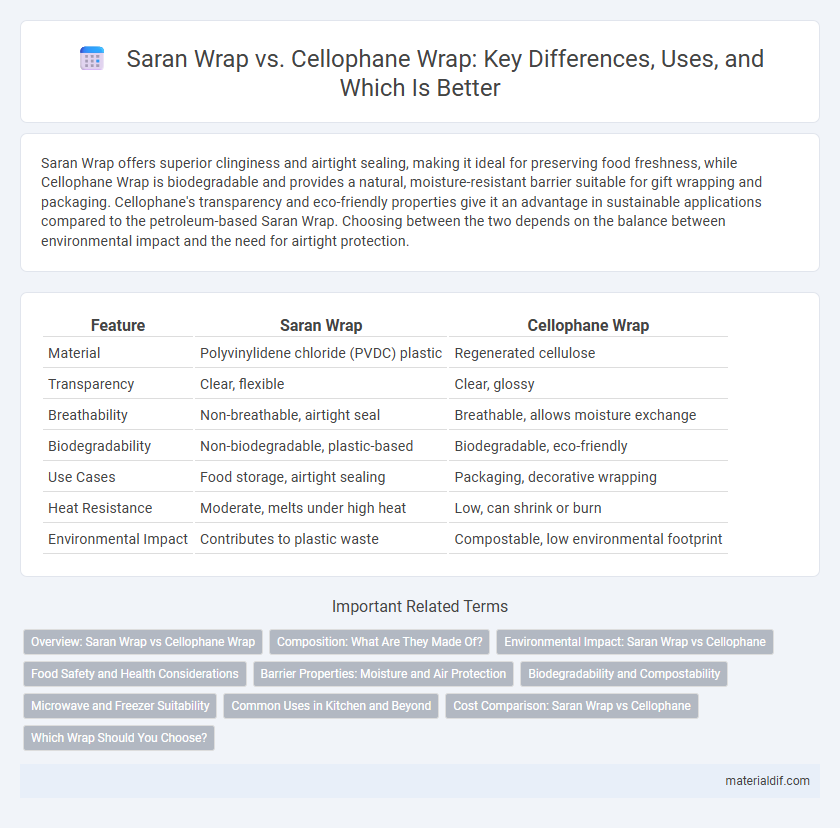Saran Wrap offers superior clinginess and airtight sealing, making it ideal for preserving food freshness, while Cellophane Wrap is biodegradable and provides a natural, moisture-resistant barrier suitable for gift wrapping and packaging. Cellophane's transparency and eco-friendly properties give it an advantage in sustainable applications compared to the petroleum-based Saran Wrap. Choosing between the two depends on the balance between environmental impact and the need for airtight protection.
Table of Comparison
| Feature | Saran Wrap | Cellophane Wrap |
|---|---|---|
| Material | Polyvinylidene chloride (PVDC) plastic | Regenerated cellulose |
| Transparency | Clear, flexible | Clear, glossy |
| Breathability | Non-breathable, airtight seal | Breathable, allows moisture exchange |
| Biodegradability | Non-biodegradable, plastic-based | Biodegradable, eco-friendly |
| Use Cases | Food storage, airtight sealing | Packaging, decorative wrapping |
| Heat Resistance | Moderate, melts under high heat | Low, can shrink or burn |
| Environmental Impact | Contributes to plastic waste | Compostable, low environmental footprint |
Overview: Saran Wrap vs Cellophane Wrap
Saran Wrap is a polyethylene-based plastic film known for its superior clinginess, moisture resistance, and durability, making it ideal for sealing food containers and preserving freshness. Cellophane wrap, derived from cellulose, offers excellent breathability and biodegradability but lacks the strong sealing and moisture barrier properties of Saran Wrap. Choosing between Saran Wrap and Cellophane wrap depends on the balance between environmental considerations and functional performance in food preservation.
Composition: What Are They Made Of?
Saran Wrap is primarily composed of low-density polyethylene (LDPE) or polyvinylidene chloride (PVDC), providing superior clinginess and airtight sealing. Cellophane wrap is made from regenerated cellulose derived from wood pulp, making it biodegradable and breathable. The differing compositions affect their moisture barrier properties and environmental impact, with Saran Wrap being more moisture-resistant and Cellophane offering eco-friendly disposal.
Environmental Impact: Saran Wrap vs Cellophane
Cellophane wrap, made from cellulose, is biodegradable and compostable, offering an eco-friendly alternative to Saran Wrap, which is produced from non-biodegradable polyethylene plastics. Saran Wrap contributes to long-lasting plastic pollution and relies on fossil fuels for production, increasing its environmental footprint. Choosing cellophane reduces landfill waste and supports sustainable packaging practices by utilizing renewable natural materials.
Food Safety and Health Considerations
Saran Wrap, made from polyvinylidene chloride (PVDC), offers a tighter seal and superior food preservation compared to traditional cellophane wrap, which is cellulose-based and biodegradable. Concerns about Saran Wrap include potential exposure to plasticizers and chemicals when heated, whereas cellophane is generally regarded as safer for direct food contact but less effective at preventing moisture loss. Selecting between Saran Wrap and cellophane depends on balancing food safety priorities with environmental impact and storage needs.
Barrier Properties: Moisture and Air Protection
Saran Wrap offers superior barrier properties against moisture and air compared to traditional cellophane wrap, providing better food preservation by minimizing exposure to oxygen and humidity. Cellophane wrap, while biodegradable, is more permeable to moisture and air, resulting in shorter shelf life for wrapped items. Its lower barrier efficiency makes Saran Wrap the preferred choice for extended freshness in food packaging.
Biodegradability and Compostability
Cellophane wrap, made from cellulose derived from wood pulp or cotton fiber, is biodegradable and compostable, breaking down naturally in soil within weeks. Saran Wrap, a brand of plastic wrap primarily composed of polyvinylidene chloride (PVDC) or polyethylene, is not biodegradable and can persist in landfills for hundreds of years. Choosing cellophane over Saran Wrap supports eco-friendly waste management by promoting compostability and reducing plastic pollution.
Microwave and Freezer Suitability
Saran Wrap, made from low-density polyethylene or polyvinylidene chloride, is highly microwave-safe, preventing melting or chemical leaching when heating food, while also maintaining strong freezer protection against moisture and freezer burn. Cellophane wrap, derived from cellulose, is biodegradable but less suitable for microwave use due to its lower heat resistance and tendency to become brittle or tear at freezing temperatures. For food storage requiring microwave reheating and freezer preservation, Saran Wrap offers superior performance and safety compared to traditional cellophane wrap.
Common Uses in Kitchen and Beyond
Saran Wrap, made from polyethylene, is widely used in kitchens for sealing food containers, preserving freshness, and preventing freezer burn due to its strong cling and moisture barrier properties. Cellophane wrap, derived from cellulose, is popular for packaging baked goods, sandwiches, and floral arrangements because of its breathability and biodegradability. Beyond the kitchen, Saran Wrap aids in industrial applications needing airtight seals, while cellophane is favored for gift wrapping and eco-friendly packaging solutions.
Cost Comparison: Saran Wrap vs Cellophane
Saran Wrap typically costs more per roll compared to traditional cellophane wrap due to its advanced plastic composition and superior airtight sealing properties. Cellophane wrap, being biodegradable and made from natural cellulose, is generally less expensive but offers lower durability and moisture resistance. The cost efficiency of cellophane makes it suitable for eco-friendly packaging, while Saran Wrap's price reflects its extended preservation capabilities.
Which Wrap Should You Choose?
Saran Wrap, made from low-density polyethylene, offers superior cling and durability, making it ideal for airtight food storage and preventing freezer burn. Cellophane wrap, derived from cellulose, is biodegradable and breathable, providing a natural alternative for wrapping fresh produce and dry goods without trapping moisture. Choose Saran Wrap for long-lasting preservation and cellophane wrap for eco-friendly packaging with breathability.
Saran Wrap vs Cellophane Wrap Infographic

 materialdif.com
materialdif.com